Brand Management Project
VerifiedAdded on 2020/12/09
|15
|3436
|428
Project
AI Summary
This project analyzes Toyota's brand management strategies, covering concepts like brand equity, brand hierarchy, and portfolio management. It also explores how Toyota builds and manages its brand over time, including strategies for overcoming brand crises and engaging customers through technology.
Contribute Materials
Your contribution can guide someone’s learning journey. Share your
documents today.
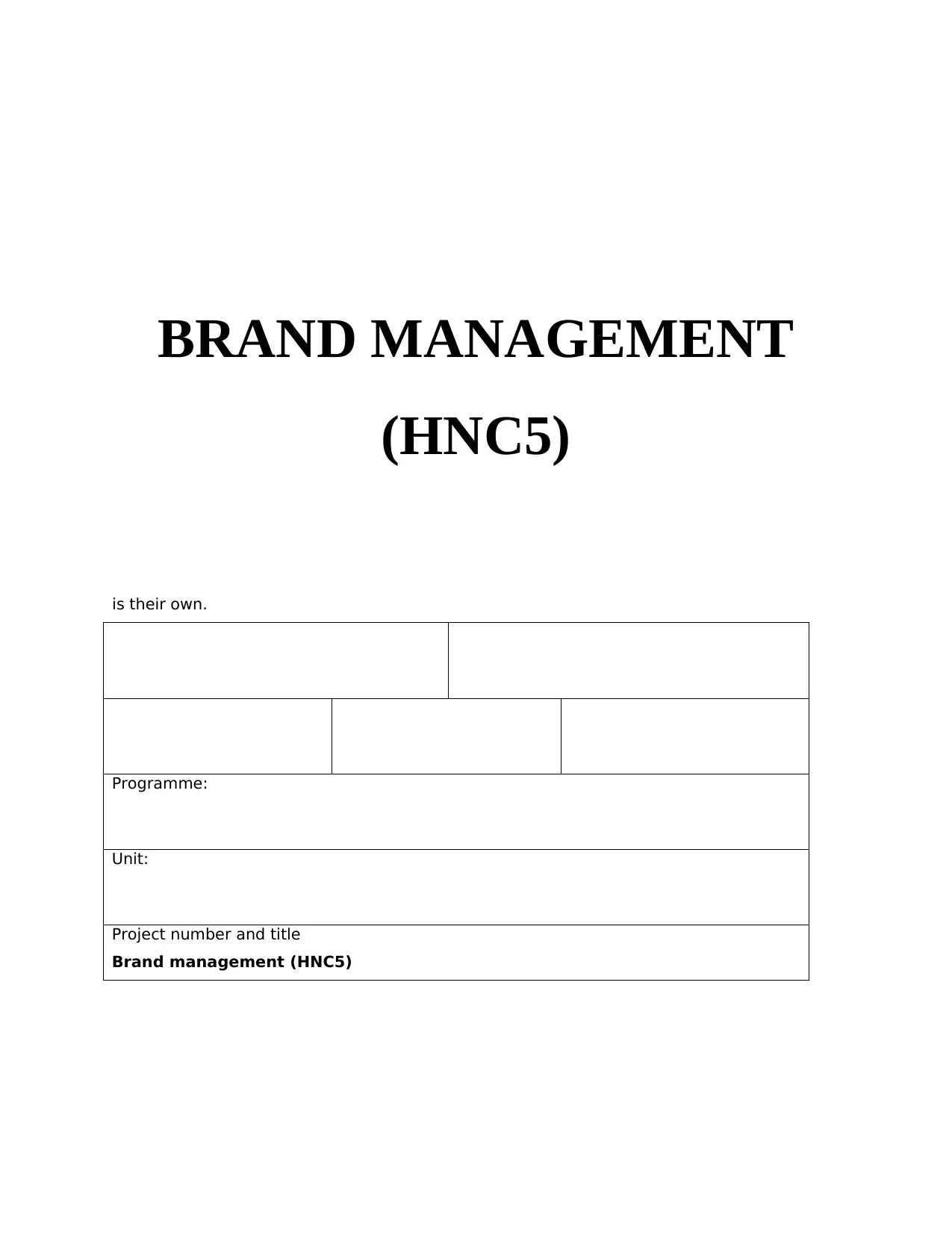
BRAND MANAGEMENT
(HNC5)
is their own.
Programme:
Unit:
Project number and title
Brand management (HNC5)
(HNC5)
is their own.
Programme:
Unit:
Project number and title
Brand management (HNC5)
Secure Best Marks with AI Grader
Need help grading? Try our AI Grader for instant feedback on your assignments.

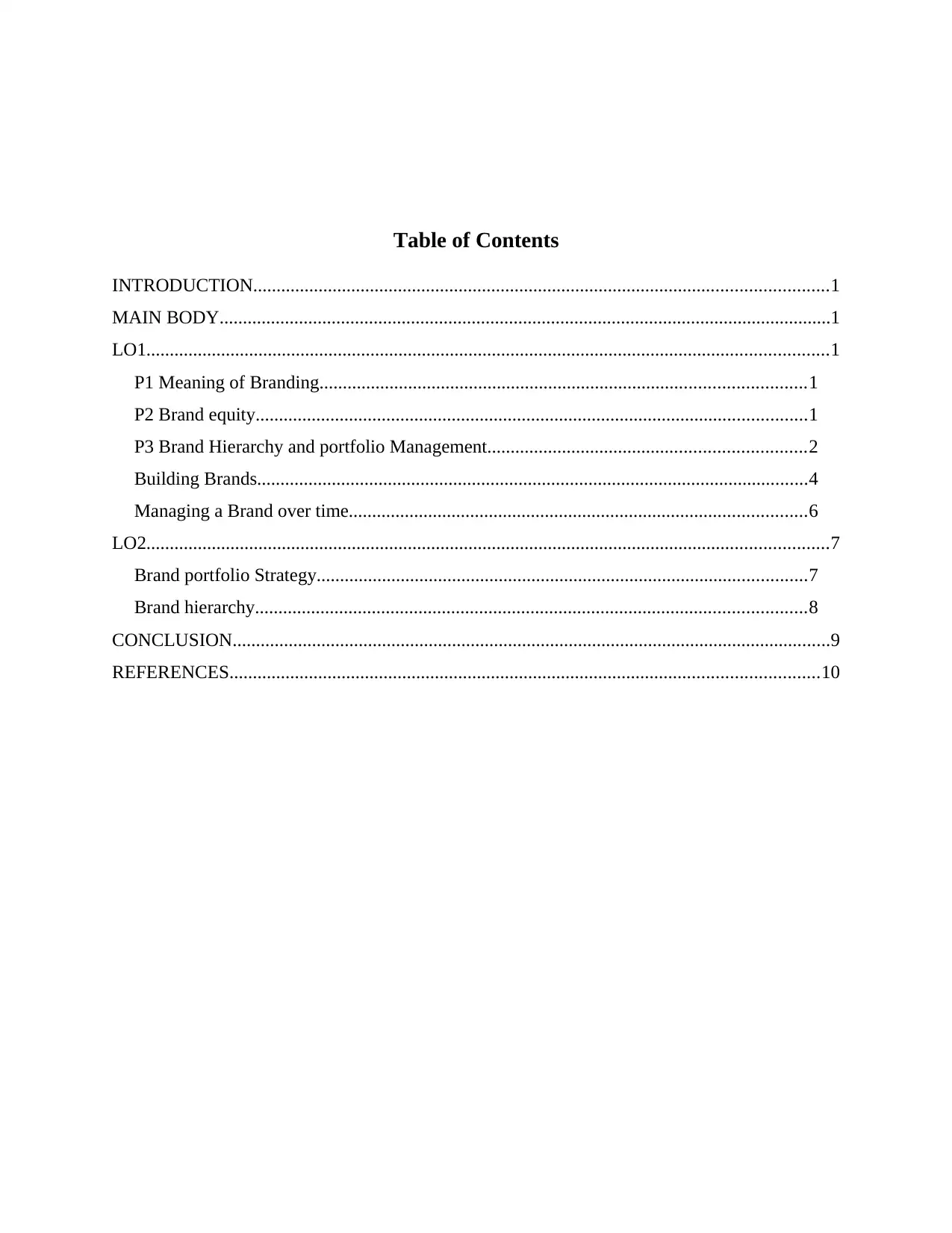
Table of Contents
INTRODUCTION...........................................................................................................................1
MAIN BODY...................................................................................................................................1
LO1..................................................................................................................................................1
P1 Meaning of Branding........................................................................................................1
P2 Brand equity......................................................................................................................1
P3 Brand Hierarchy and portfolio Management....................................................................2
Building Brands......................................................................................................................4
Managing a Brand over time..................................................................................................6
LO2..................................................................................................................................................7
Brand portfolio Strategy.........................................................................................................7
Brand hierarchy......................................................................................................................8
CONCLUSION................................................................................................................................9
REFERENCES..............................................................................................................................10
INTRODUCTION...........................................................................................................................1
MAIN BODY...................................................................................................................................1
LO1..................................................................................................................................................1
P1 Meaning of Branding........................................................................................................1
P2 Brand equity......................................................................................................................1
P3 Brand Hierarchy and portfolio Management....................................................................2
Building Brands......................................................................................................................4
Managing a Brand over time..................................................................................................6
LO2..................................................................................................................................................7
Brand portfolio Strategy.........................................................................................................7
Brand hierarchy......................................................................................................................8
CONCLUSION................................................................................................................................9
REFERENCES..............................................................................................................................10

Secure Best Marks with AI Grader
Need help grading? Try our AI Grader for instant feedback on your assignments.
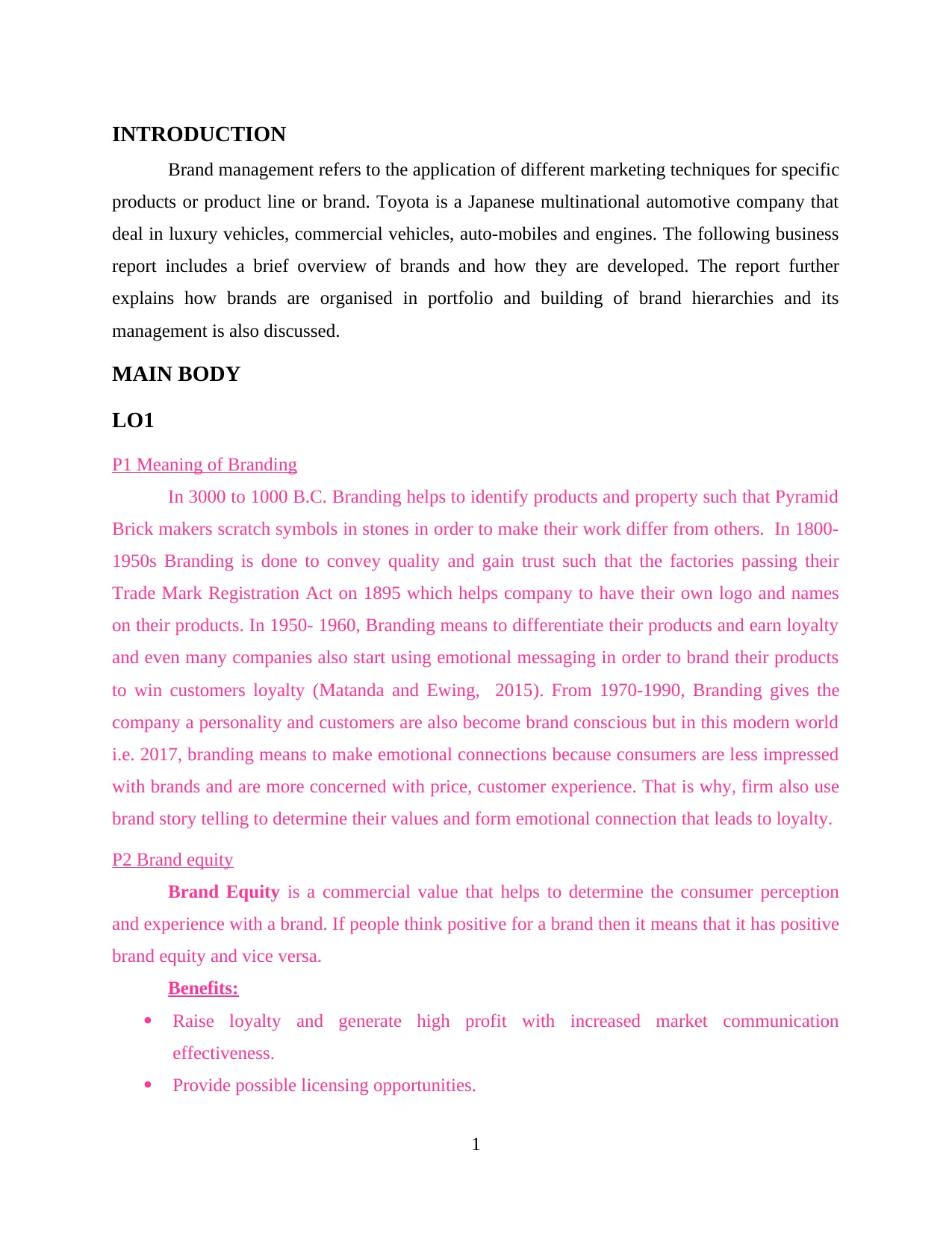
INTRODUCTION
Brand management refers to the application of different marketing techniques for specific
products or product line or brand. Toyota is a Japanese multinational automotive company that
deal in luxury vehicles, commercial vehicles, auto-mobiles and engines. The following business
report includes a brief overview of brands and how they are developed. The report further
explains how brands are organised in portfolio and building of brand hierarchies and its
management is also discussed.
MAIN BODY
LO1
P1 Meaning of Branding
In 3000 to 1000 B.C. Branding helps to identify products and property such that Pyramid
Brick makers scratch symbols in stones in order to make their work differ from others. In 1800-
1950s Branding is done to convey quality and gain trust such that the factories passing their
Trade Mark Registration Act on 1895 which helps company to have their own logo and names
on their products. In 1950- 1960, Branding means to differentiate their products and earn loyalty
and even many companies also start using emotional messaging in order to brand their products
to win customers loyalty (Matanda and Ewing, 2015). From 1970-1990, Branding gives the
company a personality and customers are also become brand conscious but in this modern world
i.e. 2017, branding means to make emotional connections because consumers are less impressed
with brands and are more concerned with price, customer experience. That is why, firm also use
brand story telling to determine their values and form emotional connection that leads to loyalty.
P2 Brand equity
Brand Equity is a commercial value that helps to determine the consumer perception
and experience with a brand. If people think positive for a brand then it means that it has positive
brand equity and vice versa.
Benefits:
Raise loyalty and generate high profit with increased market communication
effectiveness.
Provide possible licensing opportunities.
1
Brand management refers to the application of different marketing techniques for specific
products or product line or brand. Toyota is a Japanese multinational automotive company that
deal in luxury vehicles, commercial vehicles, auto-mobiles and engines. The following business
report includes a brief overview of brands and how they are developed. The report further
explains how brands are organised in portfolio and building of brand hierarchies and its
management is also discussed.
MAIN BODY
LO1
P1 Meaning of Branding
In 3000 to 1000 B.C. Branding helps to identify products and property such that Pyramid
Brick makers scratch symbols in stones in order to make their work differ from others. In 1800-
1950s Branding is done to convey quality and gain trust such that the factories passing their
Trade Mark Registration Act on 1895 which helps company to have their own logo and names
on their products. In 1950- 1960, Branding means to differentiate their products and earn loyalty
and even many companies also start using emotional messaging in order to brand their products
to win customers loyalty (Matanda and Ewing, 2015). From 1970-1990, Branding gives the
company a personality and customers are also become brand conscious but in this modern world
i.e. 2017, branding means to make emotional connections because consumers are less impressed
with brands and are more concerned with price, customer experience. That is why, firm also use
brand story telling to determine their values and form emotional connection that leads to loyalty.
P2 Brand equity
Brand Equity is a commercial value that helps to determine the consumer perception
and experience with a brand. If people think positive for a brand then it means that it has positive
brand equity and vice versa.
Benefits:
Raise loyalty and generate high profit with increased market communication
effectiveness.
Provide possible licensing opportunities.
1
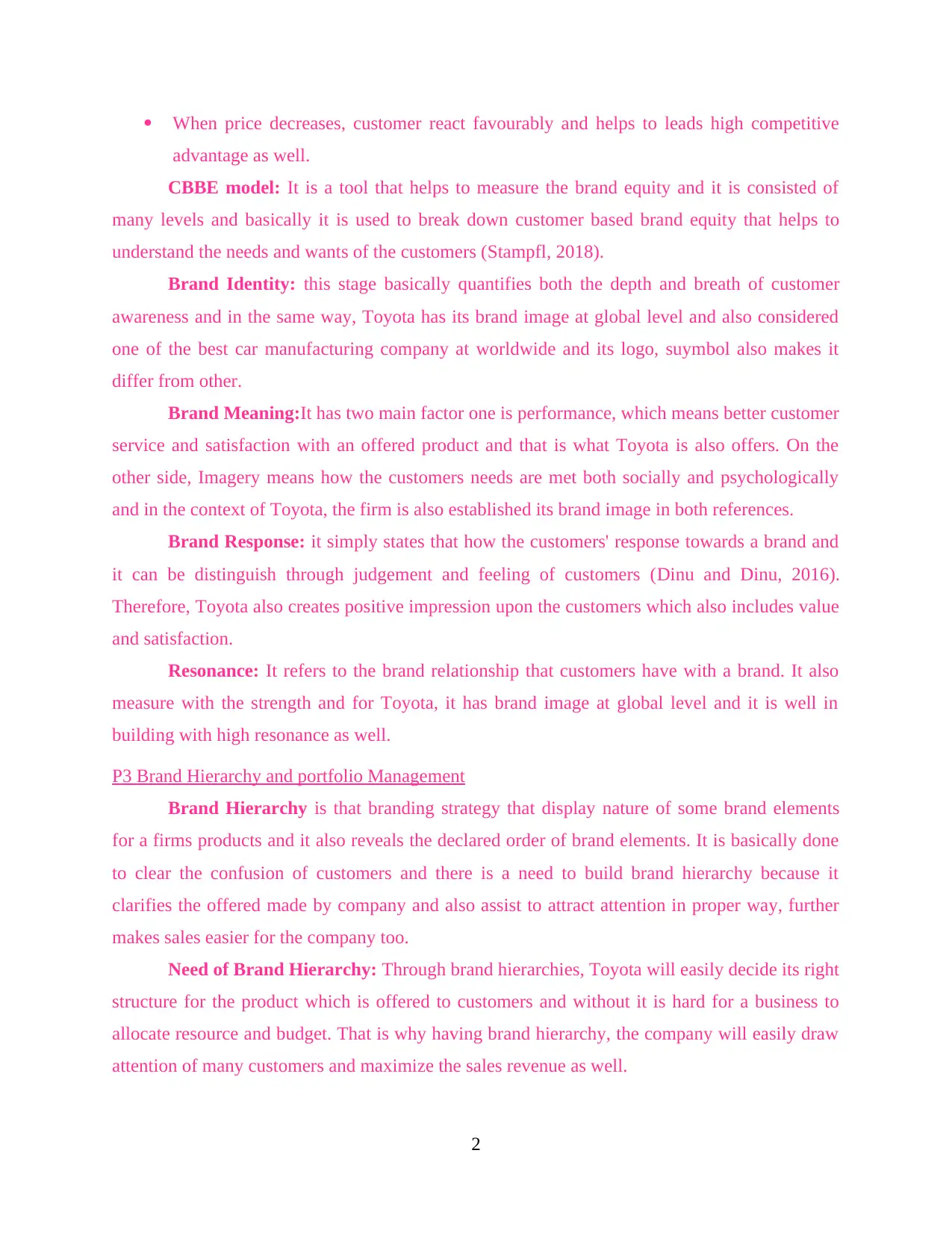
When price decreases, customer react favourably and helps to leads high competitive
advantage as well.
CBBE model: It is a tool that helps to measure the brand equity and it is consisted of
many levels and basically it is used to break down customer based brand equity that helps to
understand the needs and wants of the customers (Stampfl, 2018).
Brand Identity: this stage basically quantifies both the depth and breath of customer
awareness and in the same way, Toyota has its brand image at global level and also considered
one of the best car manufacturing company at worldwide and its logo, suymbol also makes it
differ from other.
Brand Meaning:It has two main factor one is performance, which means better customer
service and satisfaction with an offered product and that is what Toyota is also offers. On the
other side, Imagery means how the customers needs are met both socially and psychologically
and in the context of Toyota, the firm is also established its brand image in both references.
Brand Response: it simply states that how the customers' response towards a brand and
it can be distinguish through judgement and feeling of customers (Dinu and Dinu, 2016).
Therefore, Toyota also creates positive impression upon the customers which also includes value
and satisfaction.
Resonance: It refers to the brand relationship that customers have with a brand. It also
measure with the strength and for Toyota, it has brand image at global level and it is well in
building with high resonance as well.
P3 Brand Hierarchy and portfolio Management
Brand Hierarchy is that branding strategy that display nature of some brand elements
for a firms products and it also reveals the declared order of brand elements. It is basically done
to clear the confusion of customers and there is a need to build brand hierarchy because it
clarifies the offered made by company and also assist to attract attention in proper way, further
makes sales easier for the company too.
Need of Brand Hierarchy: Through brand hierarchies, Toyota will easily decide its right
structure for the product which is offered to customers and without it is hard for a business to
allocate resource and budget. That is why having brand hierarchy, the company will easily draw
attention of many customers and maximize the sales revenue as well.
2
advantage as well.
CBBE model: It is a tool that helps to measure the brand equity and it is consisted of
many levels and basically it is used to break down customer based brand equity that helps to
understand the needs and wants of the customers (Stampfl, 2018).
Brand Identity: this stage basically quantifies both the depth and breath of customer
awareness and in the same way, Toyota has its brand image at global level and also considered
one of the best car manufacturing company at worldwide and its logo, suymbol also makes it
differ from other.
Brand Meaning:It has two main factor one is performance, which means better customer
service and satisfaction with an offered product and that is what Toyota is also offers. On the
other side, Imagery means how the customers needs are met both socially and psychologically
and in the context of Toyota, the firm is also established its brand image in both references.
Brand Response: it simply states that how the customers' response towards a brand and
it can be distinguish through judgement and feeling of customers (Dinu and Dinu, 2016).
Therefore, Toyota also creates positive impression upon the customers which also includes value
and satisfaction.
Resonance: It refers to the brand relationship that customers have with a brand. It also
measure with the strength and for Toyota, it has brand image at global level and it is well in
building with high resonance as well.
P3 Brand Hierarchy and portfolio Management
Brand Hierarchy is that branding strategy that display nature of some brand elements
for a firms products and it also reveals the declared order of brand elements. It is basically done
to clear the confusion of customers and there is a need to build brand hierarchy because it
clarifies the offered made by company and also assist to attract attention in proper way, further
makes sales easier for the company too.
Need of Brand Hierarchy: Through brand hierarchies, Toyota will easily decide its right
structure for the product which is offered to customers and without it is hard for a business to
allocate resource and budget. That is why having brand hierarchy, the company will easily draw
attention of many customers and maximize the sales revenue as well.
2
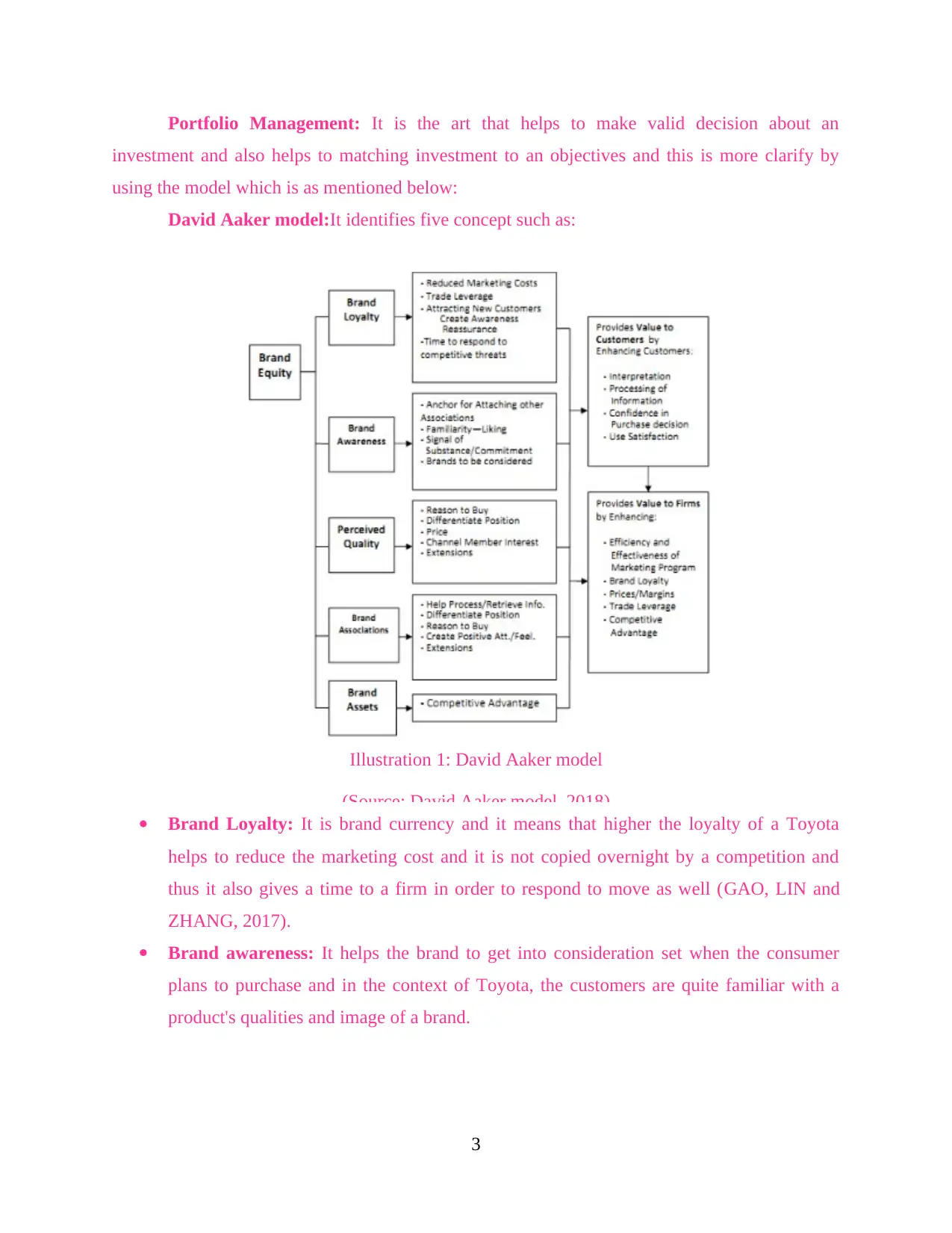
Portfolio Management: It is the art that helps to make valid decision about an
investment and also helps to matching investment to an objectives and this is more clarify by
using the model which is as mentioned below:
David Aaker model:It identifies five concept such as:
Brand Loyalty: It is brand currency and it means that higher the loyalty of a Toyota
helps to reduce the marketing cost and it is not copied overnight by a competition and
thus it also gives a time to a firm in order to respond to move as well (GAO, LIN and
ZHANG, 2017).
Brand awareness: It helps the brand to get into consideration set when the consumer
plans to purchase and in the context of Toyota, the customers are quite familiar with a
product's qualities and image of a brand.
3
Illustration 1: David Aaker model
(Source: David Aaker model, 2018)
investment and also helps to matching investment to an objectives and this is more clarify by
using the model which is as mentioned below:
David Aaker model:It identifies five concept such as:
Brand Loyalty: It is brand currency and it means that higher the loyalty of a Toyota
helps to reduce the marketing cost and it is not copied overnight by a competition and
thus it also gives a time to a firm in order to respond to move as well (GAO, LIN and
ZHANG, 2017).
Brand awareness: It helps the brand to get into consideration set when the consumer
plans to purchase and in the context of Toyota, the customers are quite familiar with a
product's qualities and image of a brand.
3
Illustration 1: David Aaker model
(Source: David Aaker model, 2018)
Paraphrase This Document
Need a fresh take? Get an instant paraphrase of this document with our AI Paraphraser
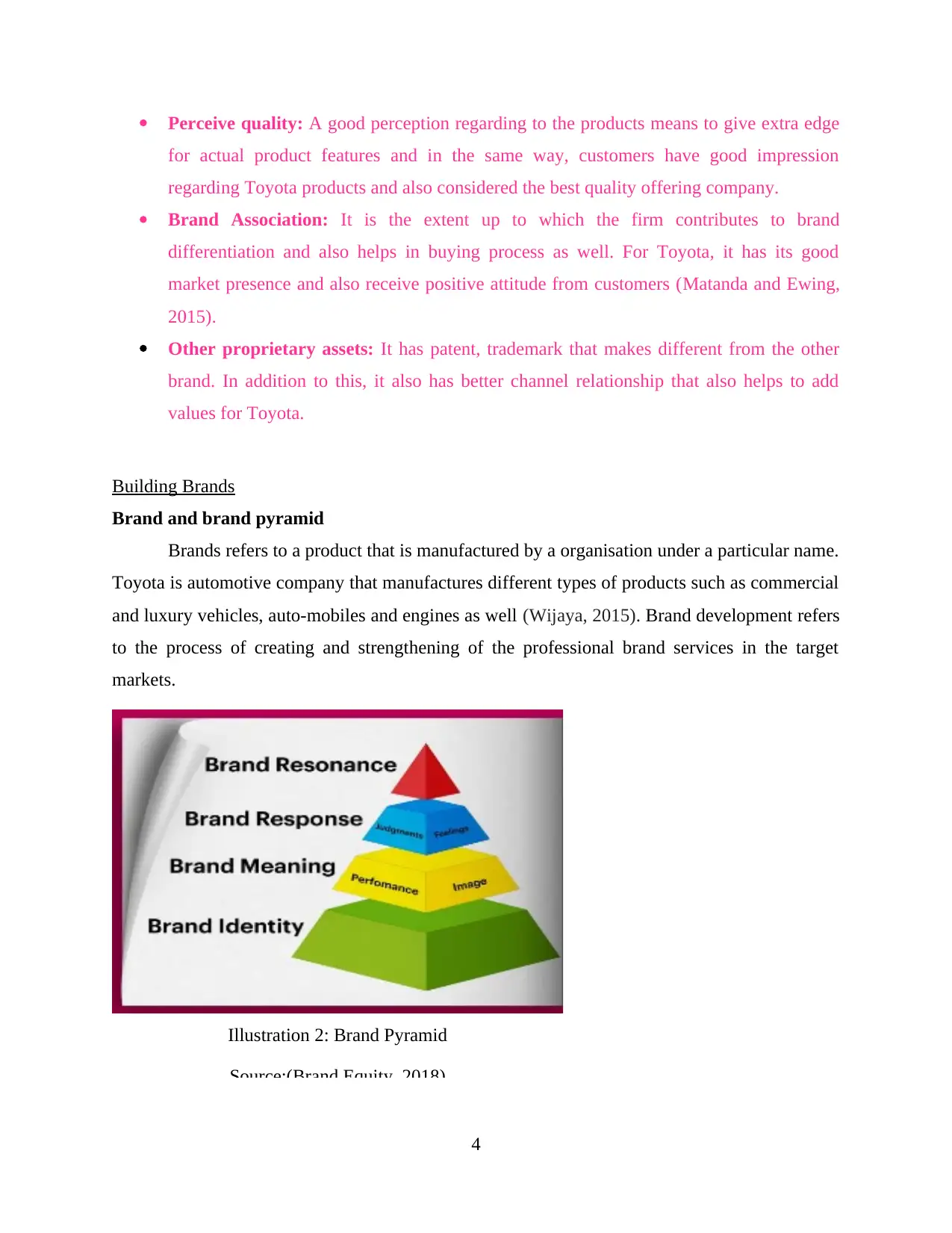
Perceive quality: A good perception regarding to the products means to give extra edge
for actual product features and in the same way, customers have good impression
regarding Toyota products and also considered the best quality offering company.
Brand Association: It is the extent up to which the firm contributes to brand
differentiation and also helps in buying process as well. For Toyota, it has its good
market presence and also receive positive attitude from customers (Matanda and Ewing,
2015).
Other proprietary assets: It has patent, trademark that makes different from the other
brand. In addition to this, it also has better channel relationship that also helps to add
values for Toyota.
Building Brands
Brand and brand pyramid
Brands refers to a product that is manufactured by a organisation under a particular name.
Toyota is automotive company that manufactures different types of products such as commercial
and luxury vehicles, auto-mobiles and engines as well (Wijaya, 2015). Brand development refers
to the process of creating and strengthening of the professional brand services in the target
markets.
Illustration 2: Brand Pyramid
Source:(Brand Equity, 2018)
4
for actual product features and in the same way, customers have good impression
regarding Toyota products and also considered the best quality offering company.
Brand Association: It is the extent up to which the firm contributes to brand
differentiation and also helps in buying process as well. For Toyota, it has its good
market presence and also receive positive attitude from customers (Matanda and Ewing,
2015).
Other proprietary assets: It has patent, trademark that makes different from the other
brand. In addition to this, it also has better channel relationship that also helps to add
values for Toyota.
Building Brands
Brand and brand pyramid
Brands refers to a product that is manufactured by a organisation under a particular name.
Toyota is automotive company that manufactures different types of products such as commercial
and luxury vehicles, auto-mobiles and engines as well (Wijaya, 2015). Brand development refers
to the process of creating and strengthening of the professional brand services in the target
markets.
Illustration 2: Brand Pyramid
Source:(Brand Equity, 2018)
4
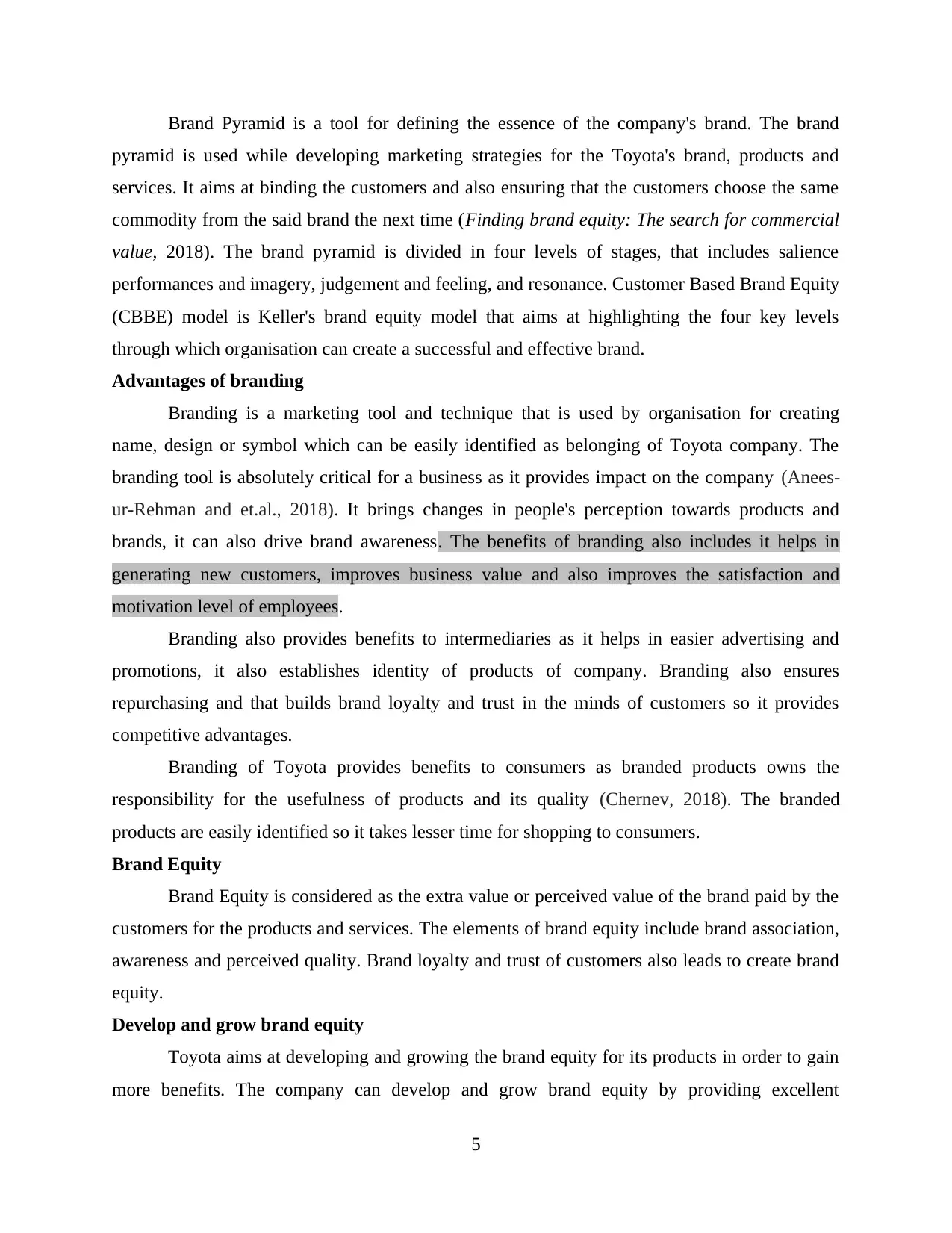
Brand Pyramid is a tool for defining the essence of the company's brand. The brand
pyramid is used while developing marketing strategies for the Toyota's brand, products and
services. It aims at binding the customers and also ensuring that the customers choose the same
commodity from the said brand the next time (Finding brand equity: The search for commercial
value, 2018). The brand pyramid is divided in four levels of stages, that includes salience
performances and imagery, judgement and feeling, and resonance. Customer Based Brand Equity
(CBBE) model is Keller's brand equity model that aims at highlighting the four key levels
through which organisation can create a successful and effective brand.
Advantages of branding
Branding is a marketing tool and technique that is used by organisation for creating
name, design or symbol which can be easily identified as belonging of Toyota company. The
branding tool is absolutely critical for a business as it provides impact on the company (Anees-
ur-Rehman and et.al., 2018). It brings changes in people's perception towards products and
brands, it can also drive brand awareness. The benefits of branding also includes it helps in
generating new customers, improves business value and also improves the satisfaction and
motivation level of employees.
Branding also provides benefits to intermediaries as it helps in easier advertising and
promotions, it also establishes identity of products of company. Branding also ensures
repurchasing and that builds brand loyalty and trust in the minds of customers so it provides
competitive advantages.
Branding of Toyota provides benefits to consumers as branded products owns the
responsibility for the usefulness of products and its quality (Chernev, 2018). The branded
products are easily identified so it takes lesser time for shopping to consumers.
Brand Equity
Brand Equity is considered as the extra value or perceived value of the brand paid by the
customers for the products and services. The elements of brand equity include brand association,
awareness and perceived quality. Brand loyalty and trust of customers also leads to create brand
equity.
Develop and grow brand equity
Toyota aims at developing and growing the brand equity for its products in order to gain
more benefits. The company can develop and grow brand equity by providing excellent
5
pyramid is used while developing marketing strategies for the Toyota's brand, products and
services. It aims at binding the customers and also ensuring that the customers choose the same
commodity from the said brand the next time (Finding brand equity: The search for commercial
value, 2018). The brand pyramid is divided in four levels of stages, that includes salience
performances and imagery, judgement and feeling, and resonance. Customer Based Brand Equity
(CBBE) model is Keller's brand equity model that aims at highlighting the four key levels
through which organisation can create a successful and effective brand.
Advantages of branding
Branding is a marketing tool and technique that is used by organisation for creating
name, design or symbol which can be easily identified as belonging of Toyota company. The
branding tool is absolutely critical for a business as it provides impact on the company (Anees-
ur-Rehman and et.al., 2018). It brings changes in people's perception towards products and
brands, it can also drive brand awareness. The benefits of branding also includes it helps in
generating new customers, improves business value and also improves the satisfaction and
motivation level of employees.
Branding also provides benefits to intermediaries as it helps in easier advertising and
promotions, it also establishes identity of products of company. Branding also ensures
repurchasing and that builds brand loyalty and trust in the minds of customers so it provides
competitive advantages.
Branding of Toyota provides benefits to consumers as branded products owns the
responsibility for the usefulness of products and its quality (Chernev, 2018). The branded
products are easily identified so it takes lesser time for shopping to consumers.
Brand Equity
Brand Equity is considered as the extra value or perceived value of the brand paid by the
customers for the products and services. The elements of brand equity include brand association,
awareness and perceived quality. Brand loyalty and trust of customers also leads to create brand
equity.
Develop and grow brand equity
Toyota aims at developing and growing the brand equity for its products in order to gain
more benefits. The company can develop and grow brand equity by providing excellent
5
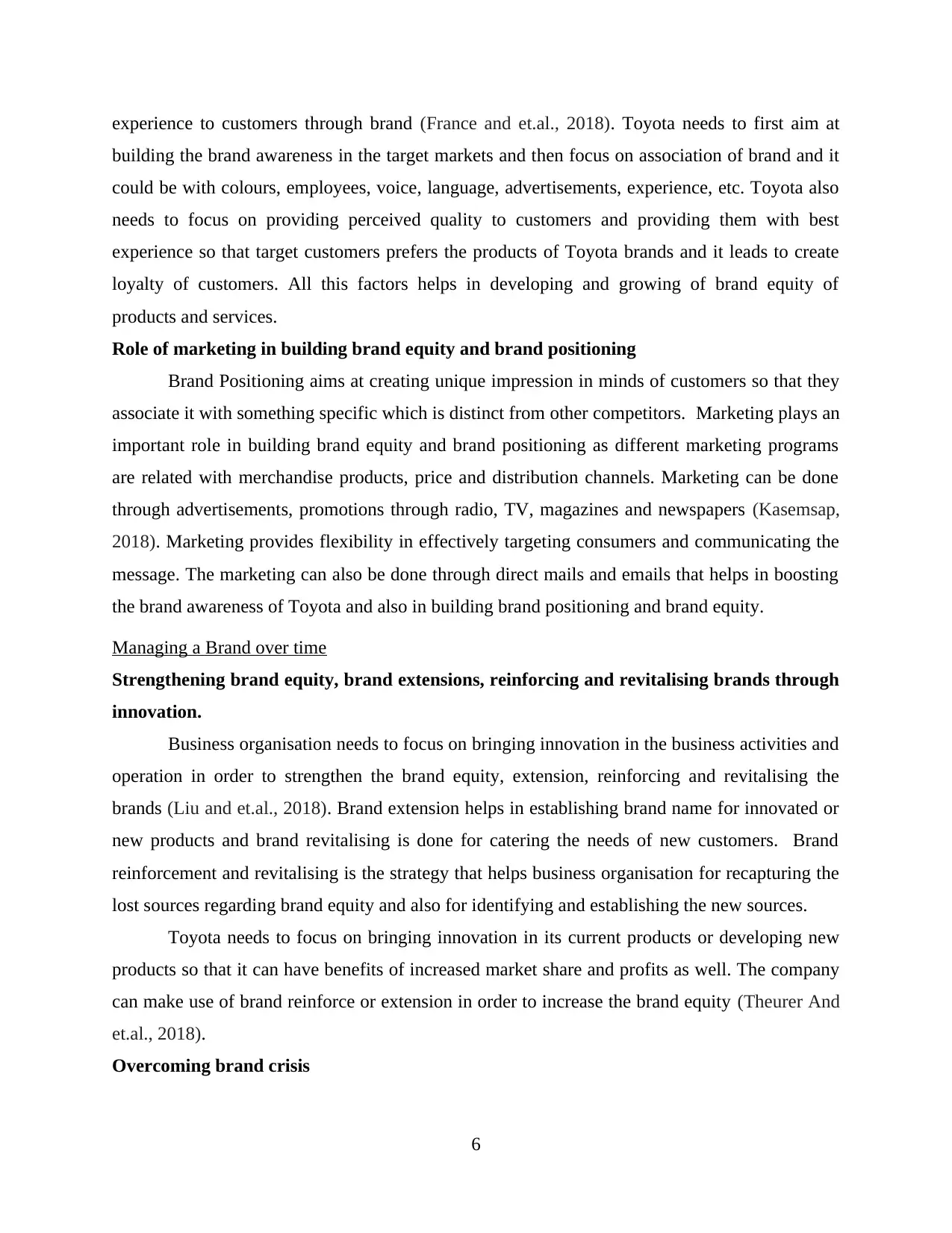
experience to customers through brand (France and et.al., 2018). Toyota needs to first aim at
building the brand awareness in the target markets and then focus on association of brand and it
could be with colours, employees, voice, language, advertisements, experience, etc. Toyota also
needs to focus on providing perceived quality to customers and providing them with best
experience so that target customers prefers the products of Toyota brands and it leads to create
loyalty of customers. All this factors helps in developing and growing of brand equity of
products and services.
Role of marketing in building brand equity and brand positioning
Brand Positioning aims at creating unique impression in minds of customers so that they
associate it with something specific which is distinct from other competitors. Marketing plays an
important role in building brand equity and brand positioning as different marketing programs
are related with merchandise products, price and distribution channels. Marketing can be done
through advertisements, promotions through radio, TV, magazines and newspapers (Kasemsap,
2018). Marketing provides flexibility in effectively targeting consumers and communicating the
message. The marketing can also be done through direct mails and emails that helps in boosting
the brand awareness of Toyota and also in building brand positioning and brand equity.
Managing a Brand over time
Strengthening brand equity, brand extensions, reinforcing and revitalising brands through
innovation.
Business organisation needs to focus on bringing innovation in the business activities and
operation in order to strengthen the brand equity, extension, reinforcing and revitalising the
brands (Liu and et.al., 2018). Brand extension helps in establishing brand name for innovated or
new products and brand revitalising is done for catering the needs of new customers. Brand
reinforcement and revitalising is the strategy that helps business organisation for recapturing the
lost sources regarding brand equity and also for identifying and establishing the new sources.
Toyota needs to focus on bringing innovation in its current products or developing new
products so that it can have benefits of increased market share and profits as well. The company
can make use of brand reinforce or extension in order to increase the brand equity (Theurer And
et.al., 2018).
Overcoming brand crisis
6
building the brand awareness in the target markets and then focus on association of brand and it
could be with colours, employees, voice, language, advertisements, experience, etc. Toyota also
needs to focus on providing perceived quality to customers and providing them with best
experience so that target customers prefers the products of Toyota brands and it leads to create
loyalty of customers. All this factors helps in developing and growing of brand equity of
products and services.
Role of marketing in building brand equity and brand positioning
Brand Positioning aims at creating unique impression in minds of customers so that they
associate it with something specific which is distinct from other competitors. Marketing plays an
important role in building brand equity and brand positioning as different marketing programs
are related with merchandise products, price and distribution channels. Marketing can be done
through advertisements, promotions through radio, TV, magazines and newspapers (Kasemsap,
2018). Marketing provides flexibility in effectively targeting consumers and communicating the
message. The marketing can also be done through direct mails and emails that helps in boosting
the brand awareness of Toyota and also in building brand positioning and brand equity.
Managing a Brand over time
Strengthening brand equity, brand extensions, reinforcing and revitalising brands through
innovation.
Business organisation needs to focus on bringing innovation in the business activities and
operation in order to strengthen the brand equity, extension, reinforcing and revitalising the
brands (Liu and et.al., 2018). Brand extension helps in establishing brand name for innovated or
new products and brand revitalising is done for catering the needs of new customers. Brand
reinforcement and revitalising is the strategy that helps business organisation for recapturing the
lost sources regarding brand equity and also for identifying and establishing the new sources.
Toyota needs to focus on bringing innovation in its current products or developing new
products so that it can have benefits of increased market share and profits as well. The company
can make use of brand reinforce or extension in order to increase the brand equity (Theurer And
et.al., 2018).
Overcoming brand crisis
6
Secure Best Marks with AI Grader
Need help grading? Try our AI Grader for instant feedback on your assignments.
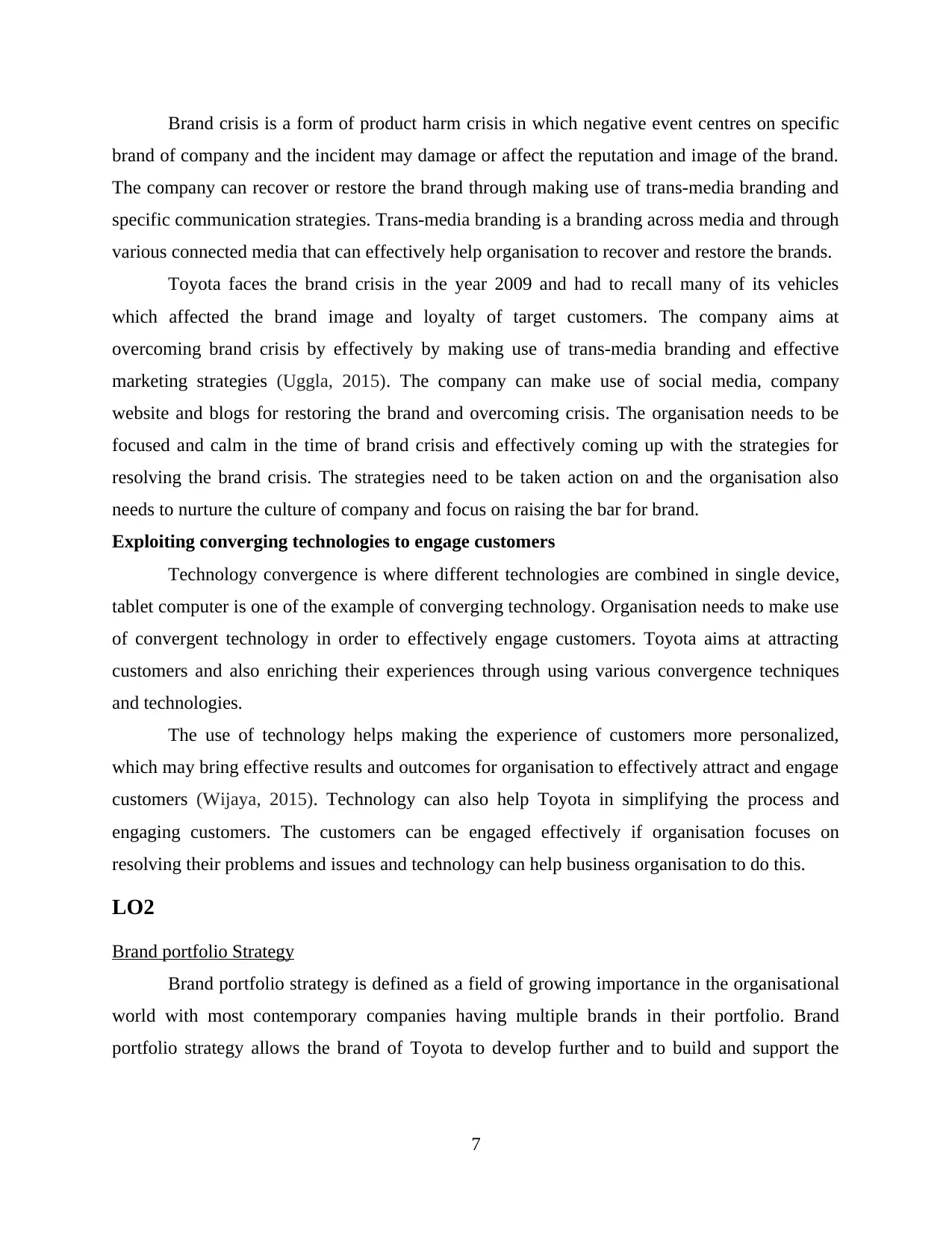
Brand crisis is a form of product harm crisis in which negative event centres on specific
brand of company and the incident may damage or affect the reputation and image of the brand.
The company can recover or restore the brand through making use of trans-media branding and
specific communication strategies. Trans-media branding is a branding across media and through
various connected media that can effectively help organisation to recover and restore the brands.
Toyota faces the brand crisis in the year 2009 and had to recall many of its vehicles
which affected the brand image and loyalty of target customers. The company aims at
overcoming brand crisis by effectively by making use of trans-media branding and effective
marketing strategies (Uggla, 2015). The company can make use of social media, company
website and blogs for restoring the brand and overcoming crisis. The organisation needs to be
focused and calm in the time of brand crisis and effectively coming up with the strategies for
resolving the brand crisis. The strategies need to be taken action on and the organisation also
needs to nurture the culture of company and focus on raising the bar for brand.
Exploiting converging technologies to engage customers
Technology convergence is where different technologies are combined in single device,
tablet computer is one of the example of converging technology. Organisation needs to make use
of convergent technology in order to effectively engage customers. Toyota aims at attracting
customers and also enriching their experiences through using various convergence techniques
and technologies.
The use of technology helps making the experience of customers more personalized,
which may bring effective results and outcomes for organisation to effectively attract and engage
customers (Wijaya, 2015). Technology can also help Toyota in simplifying the process and
engaging customers. The customers can be engaged effectively if organisation focuses on
resolving their problems and issues and technology can help business organisation to do this.
LO2
Brand portfolio Strategy
Brand portfolio strategy is defined as a field of growing importance in the organisational
world with most contemporary companies having multiple brands in their portfolio. Brand
portfolio strategy allows the brand of Toyota to develop further and to build and support the
7
brand of company and the incident may damage or affect the reputation and image of the brand.
The company can recover or restore the brand through making use of trans-media branding and
specific communication strategies. Trans-media branding is a branding across media and through
various connected media that can effectively help organisation to recover and restore the brands.
Toyota faces the brand crisis in the year 2009 and had to recall many of its vehicles
which affected the brand image and loyalty of target customers. The company aims at
overcoming brand crisis by effectively by making use of trans-media branding and effective
marketing strategies (Uggla, 2015). The company can make use of social media, company
website and blogs for restoring the brand and overcoming crisis. The organisation needs to be
focused and calm in the time of brand crisis and effectively coming up with the strategies for
resolving the brand crisis. The strategies need to be taken action on and the organisation also
needs to nurture the culture of company and focus on raising the bar for brand.
Exploiting converging technologies to engage customers
Technology convergence is where different technologies are combined in single device,
tablet computer is one of the example of converging technology. Organisation needs to make use
of convergent technology in order to effectively engage customers. Toyota aims at attracting
customers and also enriching their experiences through using various convergence techniques
and technologies.
The use of technology helps making the experience of customers more personalized,
which may bring effective results and outcomes for organisation to effectively attract and engage
customers (Wijaya, 2015). Technology can also help Toyota in simplifying the process and
engaging customers. The customers can be engaged effectively if organisation focuses on
resolving their problems and issues and technology can help business organisation to do this.
LO2
Brand portfolio Strategy
Brand portfolio strategy is defined as a field of growing importance in the organisational
world with most contemporary companies having multiple brands in their portfolio. Brand
portfolio strategy allows the brand of Toyota to develop further and to build and support the
7
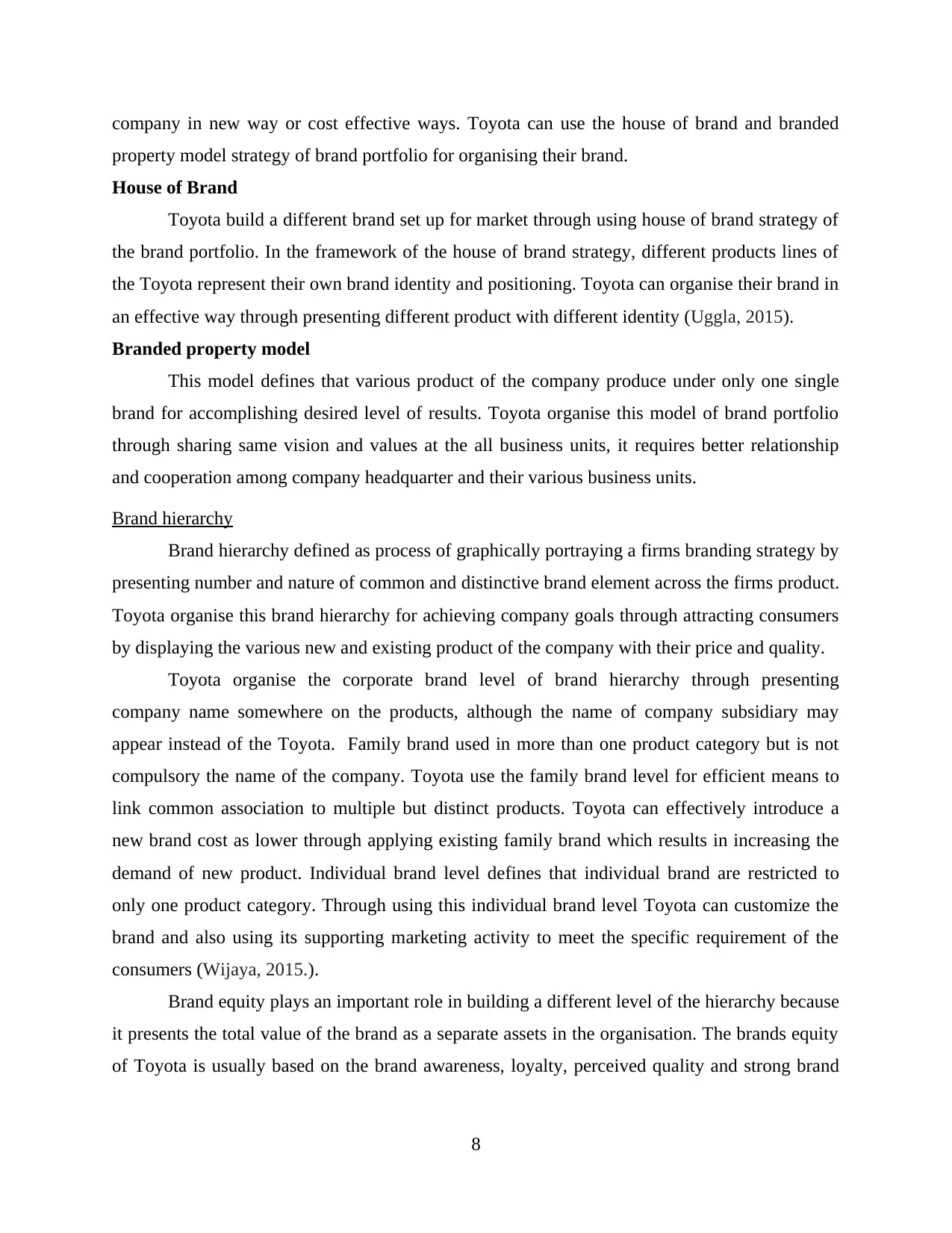
company in new way or cost effective ways. Toyota can use the house of brand and branded
property model strategy of brand portfolio for organising their brand.
House of Brand
Toyota build a different brand set up for market through using house of brand strategy of
the brand portfolio. In the framework of the house of brand strategy, different products lines of
the Toyota represent their own brand identity and positioning. Toyota can organise their brand in
an effective way through presenting different product with different identity (Uggla, 2015).
Branded property model
This model defines that various product of the company produce under only one single
brand for accomplishing desired level of results. Toyota organise this model of brand portfolio
through sharing same vision and values at the all business units, it requires better relationship
and cooperation among company headquarter and their various business units.
Brand hierarchy
Brand hierarchy defined as process of graphically portraying a firms branding strategy by
presenting number and nature of common and distinctive brand element across the firms product.
Toyota organise this brand hierarchy for achieving company goals through attracting consumers
by displaying the various new and existing product of the company with their price and quality.
Toyota organise the corporate brand level of brand hierarchy through presenting
company name somewhere on the products, although the name of company subsidiary may
appear instead of the Toyota. Family brand used in more than one product category but is not
compulsory the name of the company. Toyota use the family brand level for efficient means to
link common association to multiple but distinct products. Toyota can effectively introduce a
new brand cost as lower through applying existing family brand which results in increasing the
demand of new product. Individual brand level defines that individual brand are restricted to
only one product category. Through using this individual brand level Toyota can customize the
brand and also using its supporting marketing activity to meet the specific requirement of the
consumers (Wijaya, 2015.).
Brand equity plays an important role in building a different level of the hierarchy because
it presents the total value of the brand as a separate assets in the organisation. The brands equity
of Toyota is usually based on the brand awareness, loyalty, perceived quality and strong brand
8
property model strategy of brand portfolio for organising their brand.
House of Brand
Toyota build a different brand set up for market through using house of brand strategy of
the brand portfolio. In the framework of the house of brand strategy, different products lines of
the Toyota represent their own brand identity and positioning. Toyota can organise their brand in
an effective way through presenting different product with different identity (Uggla, 2015).
Branded property model
This model defines that various product of the company produce under only one single
brand for accomplishing desired level of results. Toyota organise this model of brand portfolio
through sharing same vision and values at the all business units, it requires better relationship
and cooperation among company headquarter and their various business units.
Brand hierarchy
Brand hierarchy defined as process of graphically portraying a firms branding strategy by
presenting number and nature of common and distinctive brand element across the firms product.
Toyota organise this brand hierarchy for achieving company goals through attracting consumers
by displaying the various new and existing product of the company with their price and quality.
Toyota organise the corporate brand level of brand hierarchy through presenting
company name somewhere on the products, although the name of company subsidiary may
appear instead of the Toyota. Family brand used in more than one product category but is not
compulsory the name of the company. Toyota use the family brand level for efficient means to
link common association to multiple but distinct products. Toyota can effectively introduce a
new brand cost as lower through applying existing family brand which results in increasing the
demand of new product. Individual brand level defines that individual brand are restricted to
only one product category. Through using this individual brand level Toyota can customize the
brand and also using its supporting marketing activity to meet the specific requirement of the
consumers (Wijaya, 2015.).
Brand equity plays an important role in building a different level of the hierarchy because
it presents the total value of the brand as a separate assets in the organisation. The brands equity
of Toyota is usually based on the brand awareness, loyalty, perceived quality and strong brand
8
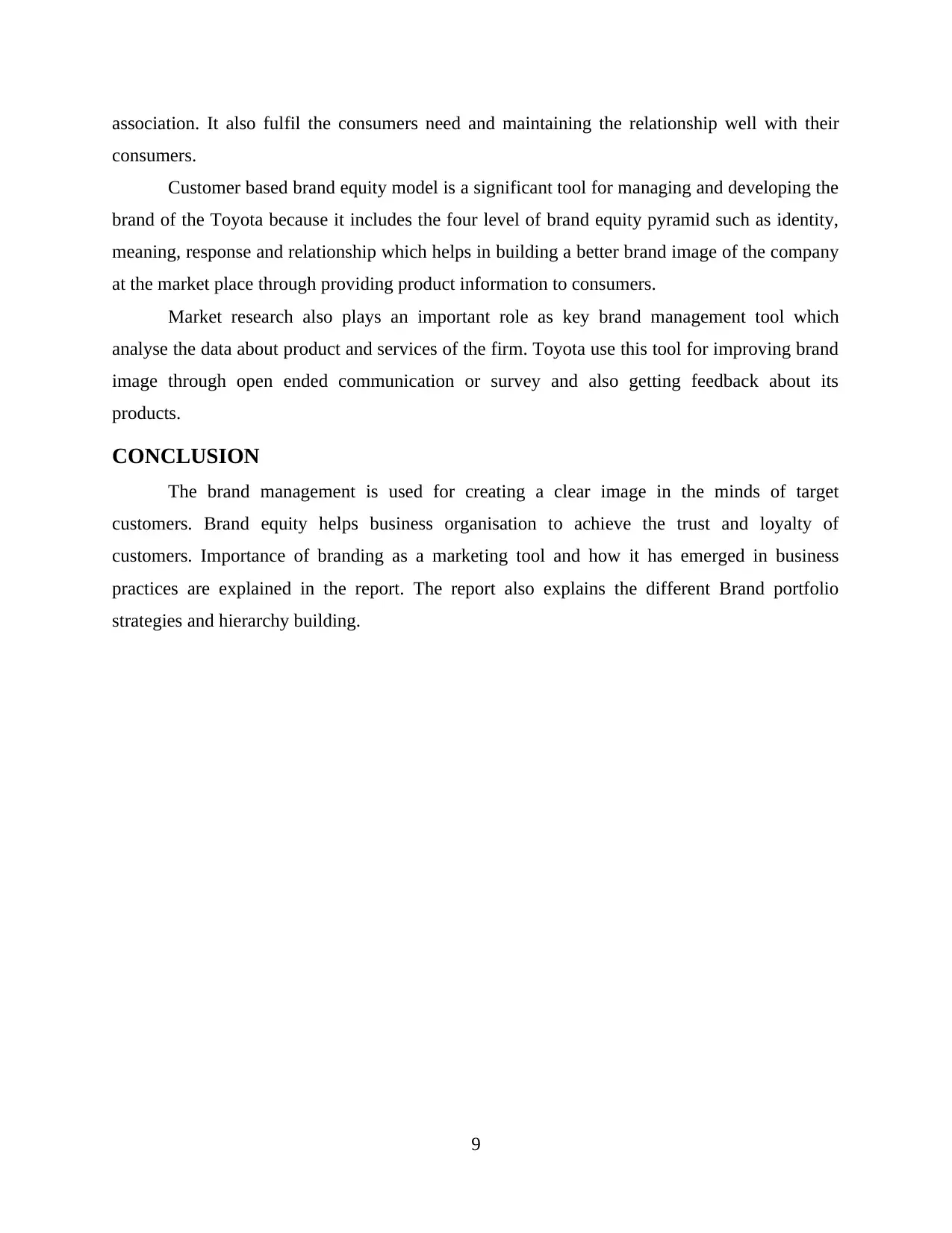
association. It also fulfil the consumers need and maintaining the relationship well with their
consumers.
Customer based brand equity model is a significant tool for managing and developing the
brand of the Toyota because it includes the four level of brand equity pyramid such as identity,
meaning, response and relationship which helps in building a better brand image of the company
at the market place through providing product information to consumers.
Market research also plays an important role as key brand management tool which
analyse the data about product and services of the firm. Toyota use this tool for improving brand
image through open ended communication or survey and also getting feedback about its
products.
CONCLUSION
The brand management is used for creating a clear image in the minds of target
customers. Brand equity helps business organisation to achieve the trust and loyalty of
customers. Importance of branding as a marketing tool and how it has emerged in business
practices are explained in the report. The report also explains the different Brand portfolio
strategies and hierarchy building.
9
consumers.
Customer based brand equity model is a significant tool for managing and developing the
brand of the Toyota because it includes the four level of brand equity pyramid such as identity,
meaning, response and relationship which helps in building a better brand image of the company
at the market place through providing product information to consumers.
Market research also plays an important role as key brand management tool which
analyse the data about product and services of the firm. Toyota use this tool for improving brand
image through open ended communication or survey and also getting feedback about its
products.
CONCLUSION
The brand management is used for creating a clear image in the minds of target
customers. Brand equity helps business organisation to achieve the trust and loyalty of
customers. Importance of branding as a marketing tool and how it has emerged in business
practices are explained in the report. The report also explains the different Brand portfolio
strategies and hierarchy building.
9
Paraphrase This Document
Need a fresh take? Get an instant paraphrase of this document with our AI Paraphraser

REFERENCES
Books and Journal
Anees-ur-Rehman, M. and et.al., 2018. How brand-oriented strategy affects the financial
performance of B2B SMEs. Journal of Business & Industrial Marketing. 33(3). pp.303-
315.
Chernev, A., 2018. Strategic brand management. Cerebellum Press.
France, C. and et.al., 2018. Customer brand co-creation behavior: conceptualization and
empirical validation. Marketing intelligence & planning. 36(3). pp.334-348
Kasemsap, K., 2018. The roles of corporate marketing strategies and brand management in the
global retail industry. In Digital Marketing and Consumer Engagement: Concepts,
Methodologies, Tools, and Applications (pp. 294-325). IGI Global.
Liu, Y. and et.al., 2018. Brand management in mergers and acquisitions: emerging market
multinationals venturing into advanced economies. International Marketing
Review. 35(5). pp.710-732.
Theurer, C.P. And et.al., 2018. Employer branding: a brand equity‐based literature review and
research agenda. International Journal of Management Reviews. 20(1). pp.155-179.
Uggla, H., 2015. Aligning Brand Portfolio Strategy with Business Strategy. IUP Journal of
Brand Management. 12(3).
Wijaya, B. S., 2015. The development of hierarchy of effects model in advertising. International
Research Journal of Business Studies. 5(1).
Matanda, T. and Ewing, M. T., 2015. The process of global brand strategy development and
regional implementation. International Journal of Research in Marketing.29(1). pp.5-12.
GAO, S., LIN, Z. M. and ZHANG, S., 2017. An Analysis and Study on Domestic Sports Brand
Marketing [J]. Journal of Anhui Normal University (Natural Science).6.
Dinu, G. and Dinu, L., 2016. The Influence of Emag Image Brand Among Resita's Online
Consumers. Ovidius University Annals, Economic Sciences Series. 16(2). pp.318-322.
Stampfl, R. W., 2018. NEW REALITIES OF RETAIL MANAGEMNT. Theory in Retailing:
Traditional and Nontraditional Sources, p.122.
Online
10
Books and Journal
Anees-ur-Rehman, M. and et.al., 2018. How brand-oriented strategy affects the financial
performance of B2B SMEs. Journal of Business & Industrial Marketing. 33(3). pp.303-
315.
Chernev, A., 2018. Strategic brand management. Cerebellum Press.
France, C. and et.al., 2018. Customer brand co-creation behavior: conceptualization and
empirical validation. Marketing intelligence & planning. 36(3). pp.334-348
Kasemsap, K., 2018. The roles of corporate marketing strategies and brand management in the
global retail industry. In Digital Marketing and Consumer Engagement: Concepts,
Methodologies, Tools, and Applications (pp. 294-325). IGI Global.
Liu, Y. and et.al., 2018. Brand management in mergers and acquisitions: emerging market
multinationals venturing into advanced economies. International Marketing
Review. 35(5). pp.710-732.
Theurer, C.P. And et.al., 2018. Employer branding: a brand equity‐based literature review and
research agenda. International Journal of Management Reviews. 20(1). pp.155-179.
Uggla, H., 2015. Aligning Brand Portfolio Strategy with Business Strategy. IUP Journal of
Brand Management. 12(3).
Wijaya, B. S., 2015. The development of hierarchy of effects model in advertising. International
Research Journal of Business Studies. 5(1).
Matanda, T. and Ewing, M. T., 2015. The process of global brand strategy development and
regional implementation. International Journal of Research in Marketing.29(1). pp.5-12.
GAO, S., LIN, Z. M. and ZHANG, S., 2017. An Analysis and Study on Domestic Sports Brand
Marketing [J]. Journal of Anhui Normal University (Natural Science).6.
Dinu, G. and Dinu, L., 2016. The Influence of Emag Image Brand Among Resita's Online
Consumers. Ovidius University Annals, Economic Sciences Series. 16(2). pp.318-322.
Stampfl, R. W., 2018. NEW REALITIES OF RETAIL MANAGEMNT. Theory in Retailing:
Traditional and Nontraditional Sources, p.122.
Online
10

Finding brand equity: The search for commercial value. 2018. [Online]. Available through:
<http://fabrikbrands.com/finding-brand-equity/>
11
<http://fabrikbrands.com/finding-brand-equity/>
11
1 out of 15
Related Documents
Your All-in-One AI-Powered Toolkit for Academic Success.
+13062052269
info@desklib.com
Available 24*7 on WhatsApp / Email
![[object Object]](/_next/static/media/star-bottom.7253800d.svg)
Unlock your academic potential
© 2024 | Zucol Services PVT LTD | All rights reserved.





